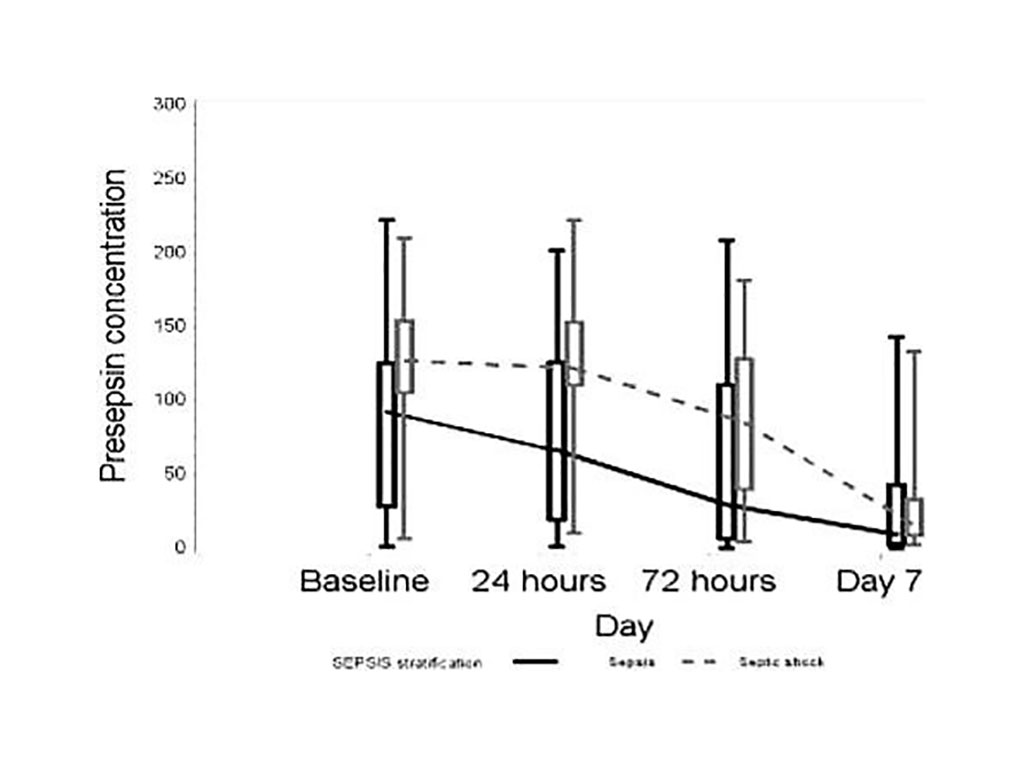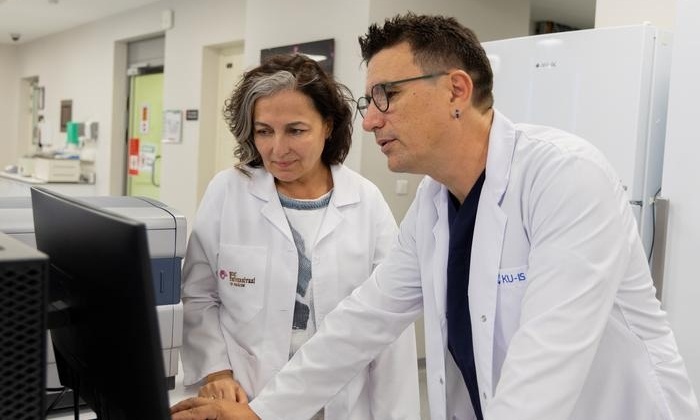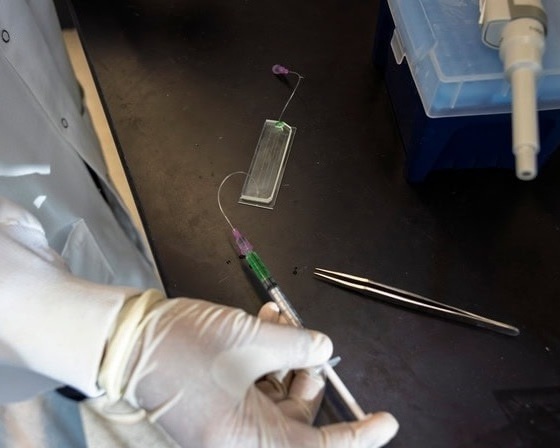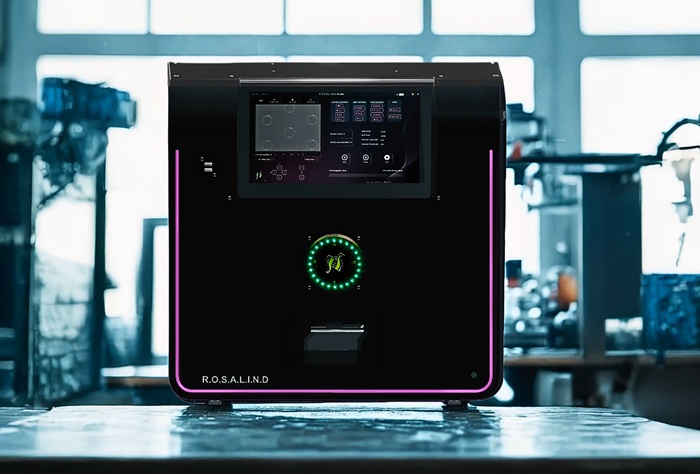Presepsin Values Evaluated as Sepsis Severity Markers
|
By LabMedica International staff writers Posted on 23 Jun 2020 |

Image: Presepsin concentrations (ng/mL) in two severity groups. Black line: sepsis patients; black dotted line: septic shock patients (Photo courtesy of University Hospital for Infectious Diseases in Zagreb).
Sepsis is a life-threatening condition, with poor and highly variable clinical manifestations, difficult to identify and diagnose. Sepsis has remained a real diagnostic challenge to clinicians, causing millions of death worldwide each year. Early recognition of sepsis is crucial for better disease outcome.
Blood cultures are a gold standard for diagnosing sepsis. Despite the great advantages, blood cultures also have some limitations as they are often negative, especially in patients previously treated with antibiotic, and their results are usually obtained over several days. While waiting for blood culture results, treatment of critically ill septic patients may be delayed, increasing the possibility of poor outcome.
Infectious disease specialist at the University Hospital for Infectious Diseases (Zagreb, Croatia) and their colleagues conducted a prospective observational study in two university clinical centers and enrolled 100 septic patients during two time periods. New Sepsis-3 definitions were used for sepsis stratification. Biomarkers and SOFA score were evaluated four times during the illness.
Routine laboratory parameters and C-reactive protein (CRP) were tested immediately. For procalcitonin (PCT) and presepsin levels measurements, blood was collected at all four time points, frozen until the end of the study, and then measured. Quantitative analysis of PCT was performed using an automated electrochemiluminescence immunoanalyzer (ELECSYS* BRAHMS* PCT; Roche Diagnostics, Mannheim, Germany). A sandwich enzyme-linked immune-sorbent assay ̶ Human Presepsin ELISA Kit (Nordic Biosite, Täby, Sweden), was used for presepsin measurement.
The following laboratory parameters were recorded: red blood cell count, hemoglobin, hematocrit, white blood cell count, platelet count, serum creatinine, serum total bilirubin, serum liver enzymes (aspartate aminotransferase-AST and alanine aminotransferase-ALT), partial thromboplastin time (PTT), international normalized ratio (INR), electrolytes (sodium and potassium), blood gas analysis, CRP, PCT, and presepsin concentrations.
The scientists reported that presepsin concentrations were significantly higher on admission in 34 patients with septic shock compared to 66 patients with sepsis, mean ± SD: 128.5 ± 47.6 ng/mL versus 88.6 ± 65.6 ng/mL, respectively. The same was not observed for PCT and CRP; their concentrations did not differ significantly between severity groups. A strong correlation of presepsin with SOFA score was also found.
The authors concluded that their study showed that serum presepsin concentration on admission reflects the severity of disease. Presepsin was a better predictor of multiple organ dysfunction syndrome compared to other tested sepsis biomarkers. The strong correlation of presepsin with SOFA score makes this marker a valuable tool for identifying septic patients. PCT and CRP concentrations did not differ between sepsis severity groups. The study was published in the June, 2020 issue of the International Journal of Infectious Diseases.
Blood cultures are a gold standard for diagnosing sepsis. Despite the great advantages, blood cultures also have some limitations as they are often negative, especially in patients previously treated with antibiotic, and their results are usually obtained over several days. While waiting for blood culture results, treatment of critically ill septic patients may be delayed, increasing the possibility of poor outcome.
Infectious disease specialist at the University Hospital for Infectious Diseases (Zagreb, Croatia) and their colleagues conducted a prospective observational study in two university clinical centers and enrolled 100 septic patients during two time periods. New Sepsis-3 definitions were used for sepsis stratification. Biomarkers and SOFA score were evaluated four times during the illness.
Routine laboratory parameters and C-reactive protein (CRP) were tested immediately. For procalcitonin (PCT) and presepsin levels measurements, blood was collected at all four time points, frozen until the end of the study, and then measured. Quantitative analysis of PCT was performed using an automated electrochemiluminescence immunoanalyzer (ELECSYS* BRAHMS* PCT; Roche Diagnostics, Mannheim, Germany). A sandwich enzyme-linked immune-sorbent assay ̶ Human Presepsin ELISA Kit (Nordic Biosite, Täby, Sweden), was used for presepsin measurement.
The following laboratory parameters were recorded: red blood cell count, hemoglobin, hematocrit, white blood cell count, platelet count, serum creatinine, serum total bilirubin, serum liver enzymes (aspartate aminotransferase-AST and alanine aminotransferase-ALT), partial thromboplastin time (PTT), international normalized ratio (INR), electrolytes (sodium and potassium), blood gas analysis, CRP, PCT, and presepsin concentrations.
The scientists reported that presepsin concentrations were significantly higher on admission in 34 patients with septic shock compared to 66 patients with sepsis, mean ± SD: 128.5 ± 47.6 ng/mL versus 88.6 ± 65.6 ng/mL, respectively. The same was not observed for PCT and CRP; their concentrations did not differ significantly between severity groups. A strong correlation of presepsin with SOFA score was also found.
The authors concluded that their study showed that serum presepsin concentration on admission reflects the severity of disease. Presepsin was a better predictor of multiple organ dysfunction syndrome compared to other tested sepsis biomarkers. The strong correlation of presepsin with SOFA score makes this marker a valuable tool for identifying septic patients. PCT and CRP concentrations did not differ between sepsis severity groups. The study was published in the June, 2020 issue of the International Journal of Infectious Diseases.
Latest Clinical Chem. News
- Noninvasive Blood-Glucose Monitoring to Replace Finger Pricks for Diabetics
- POC Breath Diagnostic System to Detect Pneumonia-Causing Pathogens
- Online Tool Detects Drug Exposure Directly from Patient Samples
- Chemical Imaging Probe Could Track and Treat Prostate Cancer
- Mismatch Between Two Common Kidney Function Tests Indicates Serious Health Problems
- VOCs Show Promise for Early Multi-Cancer Detection
- Portable Raman Spectroscopy Offers Cost-Effective Kidney Disease Diagnosis at POC
- Gold Nanoparticles to Improve Accuracy of Ovarian Cancer Diagnosis
- Simultaneous Cell Isolation Technology Improves Cancer Diagnostic Accuracy
- Simple Non-Invasive Hair-Based Test Could Speed ALS Diagnosis
- Paper Strip Saliva Test Detects Elevated Uric Acid Levels Without Blood Draws
- Prostate Cancer Markers Based on Chemical Make-Up of Calcifications to Speed Up Detection
- Breath Test Could Help Detect Blood Cancers
- ML-Powered Gas Sensors to Detect Pathogens and AMR at POC
- Saliva-Based Cancer Detection Technology Eliminates Need for Complex Sample Preparation
- Skin Swabs Could Detect Parkinson’s Years Before Symptoms Appear
Channels
Molecular Diagnostics
view channel
Endometriosis Blood Test Could Replace Invasive Laparoscopic Diagnosis
Endometriosis affects an estimated 1 in 10 women globally, yet diagnosis can take 7 to 10 years on average due to the invasive nature of laparoscopy and lack of accurate, non-invasive tests.... Read more
World's First NGS-Based Diagnostic Platform Fully Automates Sample-To-Result Process Within Single Device
Rapid point-of-need diagnostics are of critical need, especially in the areas of infectious disease and cancer testing and monitoring. Now, a direct-from-specimen platform that performs genomic analysis... Read more
Rapid Diagnostic Breakthrough Simultaneously Detects Resistance and Virulence in Klebsiella Pneumoniae
Antibiotic resistance is a steadily escalating threat to global healthcare, making common infections harder to treat and increasing the risk of severe complications. One of the most concerning pathogens... Read moreHematology
view channel
MRD Tests Could Predict Survival in Leukemia Patients
Acute myeloid leukemia is an aggressive blood cancer that disrupts normal blood cell production and often relapses even after intensive treatment. Clinicians currently lack early, reliable markers to predict... Read more
Platelet Activity Blood Test in Middle Age Could Identify Early Alzheimer’s Risk
Early detection of Alzheimer’s disease remains one of the biggest unmet needs in neurology, particularly because the biological changes underlying the disorder begin decades before memory symptoms appear.... Read more
Microvesicles Measurement Could Detect Vascular Injury in Sickle Cell Disease Patients
Assessing disease severity in sickle cell disease (SCD) remains challenging, especially when trying to predict hemolysis, vascular injury, and risk of complications such as vaso-occlusive crises.... Read more
ADLM’s New Coagulation Testing Guidance to Improve Care for Patients on Blood Thinners
Direct oral anticoagulants (DOACs) are one of the most common types of blood thinners. Patients take them to prevent a host of complications that could arise from blood clotting, including stroke, deep... Read moreImmunology
view channel
Blood Test Could Identify Colon Cancer Patients to Benefit from NSAIDs
Colon cancer remains a major cause of cancer-related illness, with many patients facing relapse even after surgery and chemotherapy. Up to 40% of people with stage III disease experience recurrence, highlighting... Read moreBlood Test Could Detect Adverse Immunotherapy Effects
Immune checkpoint inhibitors have transformed cancer treatment, but they can also trigger serious immune-related adverse events that damage healthy organs and may become life-threatening if not detected early.... Read moreMicrobiology
view channel
New UTI Diagnosis Method Delivers Antibiotic Resistance Results 24 Hours Earlier
Urinary tract infections affect around 152 million people every year, making them one of the most common bacterial infections worldwide. In routine medical practice, diagnosis often relies on rapid urine... Read more
Breakthroughs in Microbial Analysis to Enhance Disease Prediction
Microorganisms shape human health, ecosystems, and the planet’s climate, yet identifying them and understanding how they are related remains a major scientific challenge. Even with modern DNA sequencing,... Read morePathology
view channel
AI Tool Simultaneously Identifies Genetic Mutations and Disease Type
Interpreting genetic test results remains a major challenge in modern medicine, particularly for rare and complex diseases. While existing tools can indicate whether a genetic mutation is harmful, they... Read more
Rapid Low-Cost Tests Can Prevent Child Deaths from Contaminated Medicinal Syrups
Medicinal syrups contaminated with toxic chemicals have caused the deaths of hundreds of children worldwide, exposing a critical gap in how these products are tested before reaching patients.... Read more
Tumor Signals in Saliva and Blood Enable Non-Invasive Monitoring of Head and Neck Cancer
Head and neck cancers are among the most aggressive malignancies worldwide, with nearly 900,000 new cases diagnosed each year. Monitoring these cancers for recurrence or relapse typically relies on tissue... Read moreTechnology
view channel
Diagnostic Chip Monitors Chemotherapy Effectiveness for Brain Cancer
Glioblastoma is one of the most aggressive and fatal brain cancers, with most patients surviving less than two years after diagnosis. Treatment is particularly challenging because the tumor infiltrates... Read more
Machine Learning Models Diagnose ALS Earlier Through Blood Biomarkers
Amyotrophic lateral sclerosis (ALS) is a rapidly progressive neurodegenerative disease that is notoriously difficult to diagnose in its early stages. Early symptoms often overlap with other neurological... Read moreIndustry
view channel
BD and Penn Institute Collaborate to Advance Immunotherapy through Flow Cytometry
BD (Becton, Dickinson and Company, Franklin Lakes, NJ, USA) has entered into a strategic collaboration with the Institute for Immunology and Immune Health (I3H, Philadelphia, PA, USA) at the University... Read more





















